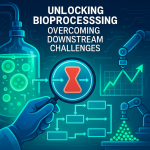🌱 They maintain cellular fitness and can enhance applications like protein tracking and sensor creation.
🔬 A new assay distinguishes agglomerates from harmful protein aggregates, advancing our understanding of protein assemblies in vivo.
💡 This novel approach opens doors for biomanufacturing, allowing reversible enzyme functions under specific conditions.
Introduction:
The article discusses recent advancements in the understanding of filamentous protein assemblies known as agglomerates, which have emerged as potential tools for intracellular engineering and synthetic biology. A novel assay developed by researchers allows for the distinction between agglomerates and damaging protein aggregates, thereby paving the way for innovative applications in biomanufacturing.
- A novel assay distinguishes agglomerates from misfolded aggregates, enabling their classification within a living cell.
- Agglomerates are formed from properly folded protein subunits and do not co-localize with the proteostasis machinery, avoiding growth defects.
- This functionality suggests that agglomerates are compatible with bio-orthogonal applications that minimize intracellular side effects.
- The reversible nature of agglomerates allows for their modulation in bioengineering applications, including novel therapeutic modalities.
- Agglomerates can enhance local protein concentrations while maintaining enzyme activity, thus offering advantages in enzyme design and bioprocessing.
Conclusion:
The findings highlight the potential of agglomerates as beneficial agents in synthetic biology and biomanufacturing, offering new pathways for protein engineering with minimal negative impact on cellular fitness. Future research will likely focus on leveraging these properties for innovative applications in bioprocessing and therapeutic development.



